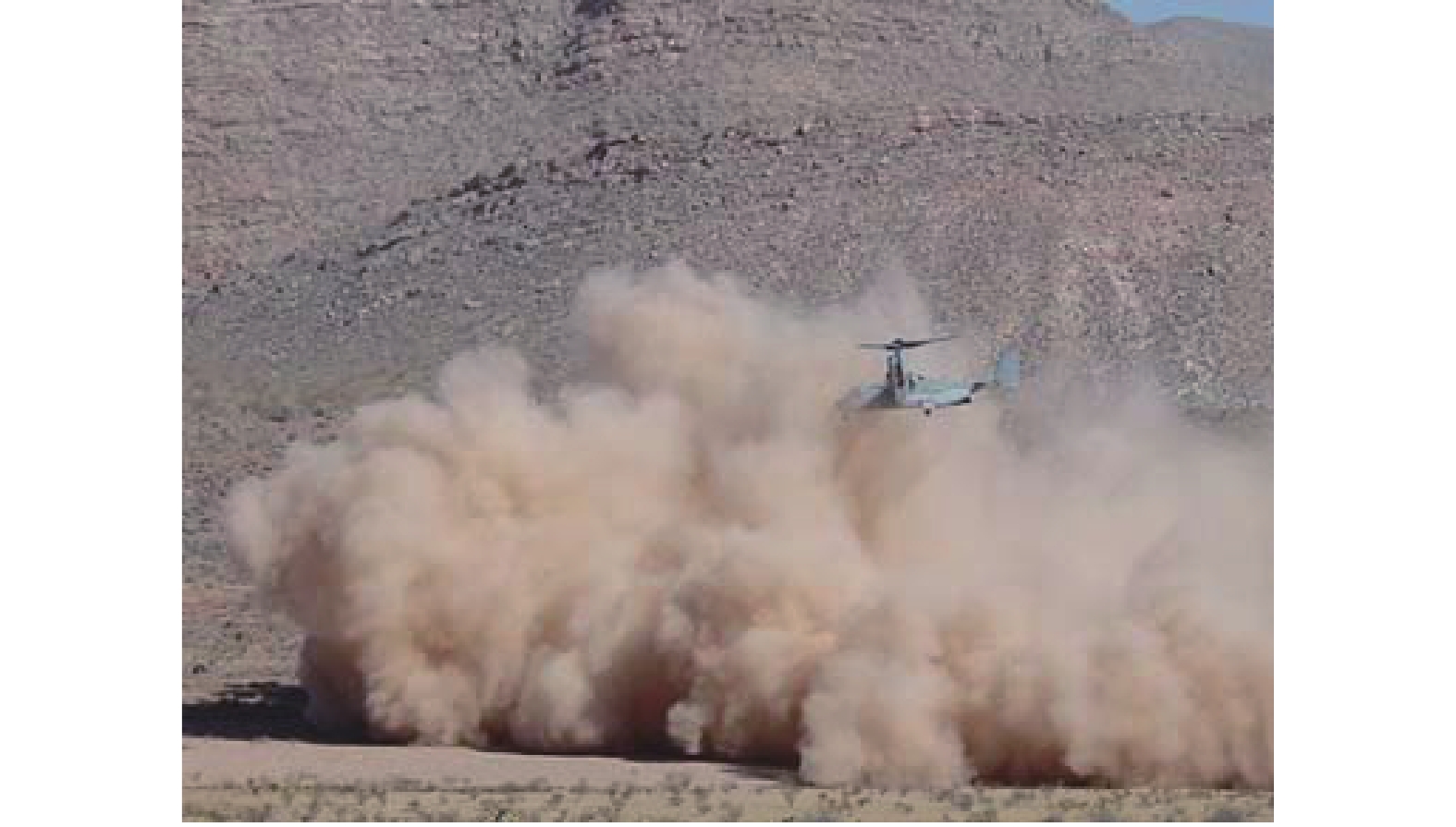| [1] |
Acquisition and Technology Programs Task Force (ATP TF). Department of defense aviation safety technologies report[R]. Washington, D. C. : Defense Safety Oversight Council, Office of the Under Secretary of Defense for Personnel and Readiness, 2009: 22-23.
|
| [2] |
BROWER M. Preventing brownout[J]. Special Operations Technology, 2004, 2(4): 1.
|
| [3] |
U. S. Department of Defense. Study of rotorcraft surviva-bility, summary briefing[R]. 2009.
|
| [4] |
ANDERSON L, DOTY P, GRIEGO M, et al. Solutions analysis for helicopter brownout[C]//Proc of the 9th Annual NDIA Systems Engineering Conference. 2006.
|
| [5] |
MILLUZZO J I, LEISHMAN J G. Vortical sheet behavior in the wake of a rotor in ground effect[J]. AIAA Journal, 2016, 55(1): 24. doi: 10.2514/1.J054498
|
| [6] |
BETZ A. The ground effect on lifting propellers[R]. NACA-TM-836, 1937.
|
| [7] |
CHEESEMAN I C, BENNETT W E. The effect of the ground on a helicopter rotor in forward flight[R]. A. R. C. Technical Report, R. & M. No. 3021, 1957.
|
| [8] |
ROSSOW V J. Effect of ground and/or ceiling planes on thrust of rotors in hover[R]. NASA-TM-86754, 1985.
|
| [9] |
何承健, 高正. 贴地飞行的旋翼尾迹研究[J]. 航空学报, 1986, 7(4): 325–331. doi: 10.3321/j.issn:1000-6893.1986.04.001HE C J, GAO Z. A study of the rotor wake in nap of the earth[J]. Acta Aeronautica et Astronautica Sinica, 1986, 7(4): 325–331. doi: 10.3321/j.issn:1000-6893.1986.04.001
|
| [10] |
DuWALDT F A. Wakes of lifting propellers (rotors) in-ground-effect[M]. Washington, D. C. : Cornell Aeronautical Laboratory, 1966.
|
| [11] |
FERGUSON S W. Rotorwash analysis handbook, volume I: Development and analysis[R]. Federal Aviation Admini-stration, Technical Report DOT/FAA/RD-93/31, 1994.
|
| [12] |
PRESTON J R, TROUTMAN S, KEEN E, et al. Rotorwash operational footprint modeling[R]. U. S. Army RDECOM Technical Report RDMRAF-14-02, 2014. doi: 10.21236/ada607614
|
| [13] |
WACHSPRESS D A, QUACKENBUSH T R, BOSCHITSCH A H. First-principles free-vortex wake analysis for helicopters and tiltrotors[C]//Proc of the 59th Annual Forum of the American Helicopter Society. 2003.
|
| [14] |
WACHSPRESS D A, WHITEHOUSE G R, KELLER J D, et al. A high fidelity brownout model for real-time flight simulations and trainers[C]//Proc of the 65th Annual Forum of the American Helicopter Society. 2009: 1281-1304.
|
| [15] |
KELLER J D, WHITEHOUSE G R, WACHSPRESS D A, et al. A physics-based model of rotorcraft brownout for flight simulation applications[C]//Proc of the 62nd Annual Forum of the American Helicopter Society. 2006.
|
| [16] |
辛冀, 李攀, 陈仁良. 地面效应中悬停旋翼的自由尾迹计算[J]. 航空学报, 2012, 33(12): 2161–2170.XIN J, LI P, CHEN R L. Free-wake analysis of hovering rotor in ground effect[J]. Acta Aeronautica et Astronautica Sinica, 2012, 33(12): 2161–2170.
|
| [17] |
D'ANDREA A. Numerical analysis of unsteady vortical flows generated by a rotorcraft operating on ground: a first assessment of helicopter brownout[C]//Proc of the 65th Annual Forum of the American Helicopter Society. 2009.
|
| [18] |
PHILLIPS C, BROWN R E. Eulerian simulation of the fluid dynamics of helicopter brownout[J]. Journal of Aircraft, 2009, 46(4): 1416–1429. doi: 10.2514/1.41999
|
| [19] |
GRIFFITHS D A, ANANTHAN S, LEISHMAN J G. Predictions of rotor performance in ground effect using a free-vortex wake model[J]. Journal of the American Helicopter Society, 2005, 50(4): 302–314. doi: 10.4050/1.3092867
|
| [20] |
SYAL M, LEISHMAN J G. Modeling of bombardment ejections in the rotorcraft brownout problem[J]. AIAA Journal, 2013, 51(4): 849–866. doi: 10.2514/1.J051761
|
| [21] |
ZHAO J G, HE C J. Physics-based modeling of viscous ground effect for rotorcraft applications[J]. Journal of the American Helicopter Society, 2015, 60(3): 1–13. doi: 10.4050/jahs.60.032006
|
| [22] |
TAN J F, SUN Y M, BARAKOS G N. Vortex approach for downwash and outwash of tandem rotors in ground effect[J]. Journal of Aircraft, 2018, 55(6): 2491–2509. doi: 10.2514/1.C034740
|
| [23] |
谭剑锋, 周天熠, 王畅, 等. 旋翼地面效应的气动建模与特性[J]. 航空学报, 2019, 40(6): 106–116.TAN J F, ZHOU T Y, WANG C, et al. Aerodynamic model and characteristics of rotor in ground effect[J]. Acta Aeronautica et Astronautica Sinica, 2019, 40(6): 106–116.
|
| [24] |
TAN J F, CAI J G, BARAKOS G N, et al. Computational study on the aerodynamic interference between tandem rotors and nearby obstacles[J]. Journal of Aircraft, 2020, 57(3): 456–468. doi: 10.2514/1.c035629
|
| [25] |
RYERSON C, HAEHNEL R, KOENIG G, et al. Visibility enhancement in rotorwash clouds[C]//Proc of the 43rd AIAA Aerospace Sciences Meeting and Exhibit. 2005: 263. doi: 10.2514/6.2005-263
|
| [26] |
WENREN Y H, WALTER J, FAN M, et al. Vorticity confinement and advanced rendering to compute and visualize complex flows[C]//Proc of the 44th AIAA Aerospace Sciences Meeting and Exhibit. 2006. doi: 10.2514/6.2006-945
|
| [27] |
HAEHNEL R B, MOULTON M A, WENREN W, et al. A model to simulate rotorcraft-induced brownout[C]//Proc of the 64th Annual Forum of the American Helicopter Society. 2008.
|
| [28] |
WENREN Y, CHITTA S, WACHSPRESS D, et al. A rotorcraft aerodynamics CFD solution method based on vorticity confinement[C]//Proc of the 66th Annual Forum of the American Helicopter Society. 2010.
|
| [29] |
THOMAS S, LAKSHMINARAYAN V K, KALRA T S, et al. Eulerian-Lagrangian analysis of cloud evolution using CFD coupled with a sediment tracking algorithm[C]//Proc of the 67th Annual Forum of the American Helicopter Society. 2011.
|
| [30] |
THOMAS S, AMIRAUX M, BAEDER J D. GPU-accelerated FVM-RANS hybrid solver for simulating two-phase flow beneath a hovering rotor[C]//Proc of the 69th Annual Forum of the American Helicopter Society. 2013.
|
| [31] |
LAKSHMINARAYAN V K, KALRA T S, BAEDER J D. Detailed computational investigation of a hovering microscale rotor in ground effect[J]. AIAA Journal, 2013, 51(4): 893–909. doi: 10.2514/1.J051789
|
| [32] |
叶靓, 招启军, 徐国华. 基于非结构嵌套网格方法的旋翼地面效应数值模拟[J]. 航空学报, 2009, 30(5): 780–786. doi: 10.3321/j.issn:1000-6893.2009.05.002YE L, ZHAO Q J, XU G H. Numerical simulation on flowfield of rotor in ground effect based on unstructured embedded grid method[J]. Acta Aeronautica et Astronautica Sinica, 2009, 30(5): 780–786. doi: 10.3321/j.issn:1000-6893.2009.05.002
|
| [33] |
朱明勇, 招启军, 王博. 基于CFD和混合配平算法的直升机旋翼地面效应模拟[J]. 航空学报, 2016, 37(8): 2539–2551. doi: 10.7527/S1000-6893.2015.0335ZHU M Y, ZHAO Q J, WANG B. Simulation of helicopter rotor in ground effect based on CFD method and hybrid trim algorithm[J]. Acta Aeronautica et Astronautica Sinica, 2016, 37(8): 2539–2551. doi: 10.7527/S1000-6893.2015.0335
|
| [34] |
RAMASAMY M, POTSDAM M, YAMAUCHI G K. Measurements to understand the flow mechanisms contributing to tandem-rotor outwash[C]//Proc of the AHS 71st Annual Forum. 2015: 612-647.
|
| [35] |
RAMASAMY M, YAMAUCHI G. Using model-scale tandem-rotor measurements in ground effect to understand full-scale CH-47D outwash[J]. Journal of the American Helicopter Society, 2017, 62(1): 1–14. doi: 10.4050/jahs.62.012004
|
| [36] |
ROVERE F, STEIJL R, BARAKOS G N. CFD Analysis of a micro rotor in ground effect[C]//Proc of the AIAA Scitech 2020 Forum. 2020. doi: 10.2514/6.2020-1793
|
| [37] |
WHITEHOUSE G R, WACHSPRESS D A, QUACKENBUSH T R, et al. Exploring aerodynamic methods for mitigating brownout[C]//Proc of the 65th Annual Forum of the American Helicopter Society. 2009.
|
| [38] |
D'ANDREA A, SCORCELLETTI F. Enhanced numerical simulations of helicopter landing maneuvers in brownout conditions[C]//Proc of the 66th Annual Forum of the American Helicopter Society. 2010.
|
| [39] |
PHILLIPS C, KIM H W, BROWN R E. The flow physics of helicopter brownout[C]//Proc of the 66th Annual Forum of the American Helicopter Society. 2010.
|
| [40] |
JOHNSON B, LEISHMAN J G, SYDNEY A. Investigation of sediment entrainment in brownout using high-speed particle image velocimetry[C]//Proc of the 65th Annual Forum of the American Helicopter Society. 2009.
|
| [41] |
SYAL M, GOVINDARAJAN B, LEISHMAN J G. Mesoscale sediment tracking methodology to analyze brownout cloud developments[C]//Proc of the 66th Annual Forum of the American Helicopter Society. 2010.
|
| [42] |
SYAL M, LEISHMAN J G. Predictions of brownout dust clouds compared to photogrammetry measurements[J]. Journal of the American Helicopter Society, 2013, 58(2): 1–18. doi: 10.4050/jahs.58.022001
|
| [43] |
GOVINDARAJAN B M, LEISHMAN J G. Predictions of rotor and rotor/airframe configurational effects on brownout dust clouds[J]. Journal of Aircraft, 2015, 53(2): 545–560. doi: 10.2514/1.C033447
|
| [44] |
SHAO Y, RAUPACH M R, FINDLATER P A. Effect of saltation bombardment on the entrainment of dust by wind[J]. Journal of Geophysical Research Atmospheres, 1993, 98(D7): 12719–12726. doi: 10.1029/93JD00396
|
| [45] |
GOVINDARAJAN B, LEISHMAN J G, GUMEROV N A. Evaluation of particle clustering algorithms in the prediction of brownout dust clouds[C]//Proc of the 67th Annual Forum of the American Helicopter Society. 2011: 325-347.
|
| [46] |
HU Q, GUMEROV N A, SYAL M, et al. Toward improved aeromechanics simulation using recent advancements in scientific computing[C]//Proc of the 67th Annual Forum of the American Helicopter Society. 2011: 2105-2119.
|
| [47] |
TAN J F, GAO J E, BARAKOS G N, et al. Novel approach to helicopter brownout based on vortex and discrete element methods[J]. Aerospace Science and Technology, 2021, 116: 106839. doi: 10.1016/j.ast.2021.106839
|
| [48] |
谭剑锋, 何龙, 于领军, 等. 基于黏性涡粒子/沙粒DEM的直升机沙盲建模[J]. 航空学报, 2022, 43(8): 351–361. doi: 10.7527/sl000-6893.2021.25536TAN J F, HE L, YU L J, et al. Helicopter brownout modeling based on viscous vortex particle and sand particle DEM[J]. Acta Aeronautica et Astronautica Sinica, 2022, 43(8): 351–361. doi: 10.7527/sl000-6893.2021.25536
|
| [49] |
TAN J F, YON T, HE L, et al. Accelerated method of helicopter brownout with particle-particle collisions[J]. Aerospace Science and Technology, 2022, 124: 107511. doi: 10.1016/j.ast.2022.107511
|
| [50] |
谭剑锋, 韩水, 王畅, 等. 基于DEM的直升机沙盲加速计算方法[J]. 北京航空航天大学学报, 2023, 49(6): 1352–1361. doi: 10.13700/j.bh.1001-5965.2021.0450TAN J F, HAN S, WANG C, et al. Accelerated computational method of helicopter brownout based on DEM[J]. Journal of Beijing University of Aeronautics and Astronautics, 2023, 49(6): 1352–1361. doi: 10.13700/j.bh.1001-5965.2021.0450
|
| [51] |
KUTZ B M, GUNTHER T, RUMPF A, et al. Numerical examination of a model rotor in brownout conditions[C]//Proc of the 70th Annual Forum of the American Helicopter Society. 2014: 2450-2461.
|
| [52] |
BARAKOS G N, FITZGIBBON T, KUSYUMOV A N, et al. CFD simulation of helicopter rotor flow based on unsteady actuator disk model[J]. Chinese Journal of Aeronautics, 2020, 33(9): 2313–2328. doi: 10.1016/j.cja.2020.03.021
|
| [53] |
HU J P, XU G H, SHI Y J, et al. A numerical simulation investigation of the influence of rotor wake on sediment particles by computational fluid dynamics coupling discrete element method[J]. Aerospace Science and Technology, 2020, 105: 106046. doi: 10.1016/j.ast.2020.106046
|
| [54] |
胡健平, 徐国华, 史勇杰, 等. 基于CFD-DEM耦合数值模拟的全尺寸直升机沙盲形成机理[J]. 航空学报, 2020, 41(3): 154–168.HU J P, XU G H, SHI Y J, et al. Formation mechanism of brownout in full-scale helicopter based on CFD-DEM couplings numerical simulation[J]. Acta Aeronautica et Astronautica Sinica, 2020, 41(3): 154–168.
|
| [55] |
PORCÙ R, MIGLIO E, PAROLINI N, et al. HPC simulations of brownout: A noninteracting particles dynamic model[J]. The International Journal of High Performance Computing Applications, 2020, 34(3): 267–281. doi: 10.1177/1094342020905971
|
| [56] |
TAN J F, GE Y Y, ZHANG W G, et al. Numerical study on helicopter brownout with crosswind[J]. Aerospace Science and Technology, 2022, 131: 107965. doi: 10.1016/j.ast.2022.107965
|
| [57] |
SAIJO T, GANESH B, HUANG A, et al. Development of unsteadiness in a rotor wake in ground effect[C]//Proc of the 21st AIAA Applied Aerodynamics Conference. 2003. doi: 10.2514/6.2003-3519
|
| [58] |
NATHAN N D. The rotor wake in ground effect and its investigation in a wind tunnel[D]. Scotland, UK: University of Glasgow, 2010.
|
| [59] |
LEE T, LEISHMAN J G, RAMASAMY M. Fluid dynamics of interacting blade tip vortices with a ground plane[C]//Proc of the 64th Annual Forum of the American Helicopter Society. 2008. doi: 10.4050/jahs.55.022005
|
| [60] |
BRADLEY J, LEISHMAN J G, SYDNEY A, et al. Investigation of sediment entrainment in brownout using high-speed particle image velocimetry[C]//Proc of the 65th Annual Forum of the American Helicopter Society. 2009.
|
| [61] |
RODGERS S J. Evaluation of the gust cloud generated by helicopter rotor downwash[R]. U. S. Army Aviation Materiel Laboratories Technical Report, 1968.
|
| [62] |
NATHAN N D, GREEN R B. Measurements of a rotor flow in ground effect and visualization of the brown-out phenomenon[C]//Proc of the 64th Annual Forum of the American Helicopter Society. 2008.
|
| [63] |
SYDNEY A, LEISHMAN J G. Measurements of rotor/airframe interactions in ground effect over a sediment bed[C]//Proc of the 69th Annual Forum of the American Helicopter Society. 2013.
|
| [64] |
SYDNEY A, BAHARANI A, LEISHMAN J G. Under-standing brownout using near-wall dual-phase flow measure-ments[C]//Proc of the 67th Annual Forum of the American Helicopter Society. 2011.
|
| [65] |
SYDNEY A, LEISHMAN J G. Measurements of the plume-like three-dimensionality of rotor-induced dust fields[C]//Proc of the 70th Annual Forum of the American Helicopter Society. 2014.
|
| [66] |
COWHERD C, Jr. Sandblaster 2: support of see-through technologies for particulate brownout[R]. Defence Advanced Research Projects Agency (DARPA), Technical Report 110565, 2007.
|
| [67] |
TANNER P E. Photogrammetric characterization of a brownout cloud[C]//Proc of the 67th Annual Forum of the American Helicopter Society. 2011: 3039-3055.
|
| [68] |
WONG O D, TANNER P E. Photogrammetric measure-ments of an EH-60L brownout cloud[J]. Journal of the American Helicopter Society, 2016, 61(1): 1–10. doi: 10.4050/jahs.61.012003
|
| [69] |
SPOLDI S, ENGEL D, FAYNBERGY A, et al. CH-53K control laws: improved safety and performance in the degraded visual environment[C]//Proc of the Vertical Flight Society‘s 76th Annual Forum & Technology Display, 2020. doi: 10.4050/f-0076-2020-16390
|
| [70] |
WHITEHOUSE G R, WACHSPRESS D A, QUACKENBUSH T R. Aerodynamic design of helicopter rotors for reduced brownout[C]//Proc of the International Powered Lift Conference Proceedings. 2010.
|
| [71] |
STAFF A H S. British merlin in comba operations: lessons learned[C]//Vertiflite, Fall 2008, American Helicopter Society. 2008.
|
| [72] |
SLADE K. Sharp new blades improve sea kings[R/OL]. UK Ministry of Defense. 2008. http://www.mod.uk/NR/rdonlyres/C5EA5D7B-D39C-49EE-ADE0-F721525ECA1D/0/desider_04_aug08.pdf.
|
| [73] |
PRIOT A-E, ALBERY W. Rotary-wing brownout mitiga-tion: technologies and training[R]. North Atlantic Treaty Organisation, RTO-TR-HFM-162, 2012.
|
| [74] |
HARRINGTON W, BRADDOM S SAVAGE J, et al. 3D-LZ brownout landing solution[C]//Proc of the 66th Annual Forum of the American Helicopter Society. 2010.
|
| [75] |
SZOBOSZLAY Z P, FUJIZAWA B T, OTT C R, et al. 3D-LZ flight test of 2013: landing an EH-60L helicopter in a brownout Degraded Visual Environment[C]//Proc of the 70th Annual Forum of the American Helicopter Society. 2014. doi: 10.13140/2.1.4978.7525
|
| [76] |
TURPIN T S, SYKORA B, NEISWANDER G M, et al. Brownout landing aid system technology (BLAST)[C]//Proc of the 66th Annual Forum of the American Helicopter Society. 2010.
|
| [77] |
NEISWANDER G M. Improving deceleration guidance for rotorcraft brownout landing[C]//Proc of the 67th Annual Forum of the American Helicopter Society. 2011.
|
| [78] |
ROY G, ROY S, GAO X Y. Helicopter flight test of the Obscurant Penetrating Autosynchronous Lidar (OPAL) in degraded visual environments: part II – see-through capabi-lity assessment[C]//Proc of the AHS 70th Annual Forum. 2014.
|
| [79] |
SZOBOSZLAY Z, DAVIS B, FUJIZAWA B T, et al. Degraded Visual Environment Mitigation (DVE-M) Program, Yuma 2016 flight trials[C]//Proc of the American Helicopter Society 73rd Annual Forum & Technology Display, 2017.
|
| [80] |
MILLER J D, GODFROY-COOPER M, SZOBOSZLAY Z P. Degraded Visual Environment Mitigation (DVE-M) Program, bumper Radar obstacle cueing flight trials 2020[C]//Proc of the Vertical Flight Society’s 77th Annual Forum and Technology Display. 2021. doi: 10.4050/F-0077-2021-16747
|








 下载:
下载:












































